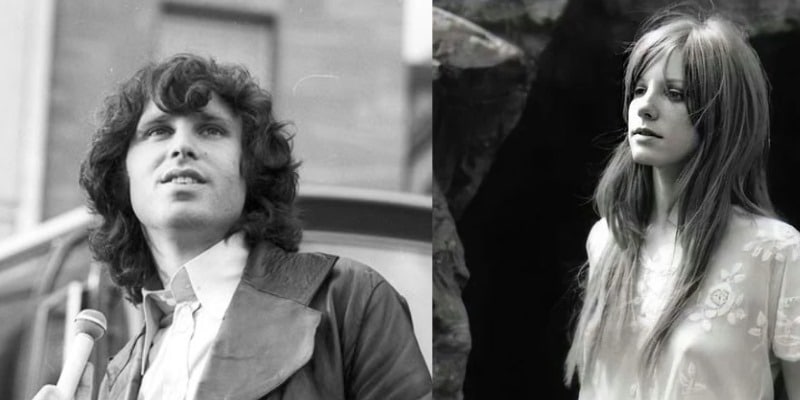Few partnerships in the history of rock have remained as mysteriously powerful as Jim Morrison and Pamela Courson’s. In reality, their relationship was remarkably similar to the music Morrison composed—provocative, poetic, and profoundly human—despite being frequently depicted as chaotic or doomed. Pamela was much more than just a “girlfriend”; she was The Doors’ legendary frontman’s creative collaborator, inspiration, and emotional compass.
London Fog, a dimly lit club on the Sunset Strip, is where they first met in 1966. Courson, an art student at the time, had an air of calm that concealed her inner intensity, while Morrison was a budding artist struggling with expectations and identity. Their relationship developed like a surrealist book after that night, characterized by cultural rebellion, psychological complexity, and tender devotion. Pamela was instrumental in transforming the Lizard King’s unadulterated creativity into something incredibly powerful by supporting Jim’s poetic voice over his rock persona.
Pamela Courson – Biography & Legacy
| Attribute | Details |
|---|---|
| Full Name | Pamela Susan Courson |
| Born | December 22, 1946 – Weed, California |
| Died | April 25, 1974 (aged 27) – Los Angeles, California |
| Known For | Long-term partner and muse of Jim Morrison (The Doors) |
| Occupation | Boutique owner (Themis, Los Angeles) |
| Relationship Status | Recognized as Morrison’s common-law wife; named sole heir in his will |
| Cultural Influence | Inspiration for songs such as “Love Street” and “Orange County Suite” |
| Burial Site | Fairhaven Memorial Park, Santa Ana, California |
| Reference Link | Wikipedia – Pamela Courson , IMDb |
A Bond That Branded, Burned, and Ignited an Entire Generation
Not only was Pamela and Jim’s relationship unusual in the context of the counterculture of the 1960s, but it also served a very diverse purpose. In addition to being romantic partners, they were also co-conspirators in an extravagant, rebellious, and artistic lifestyle. Morrison’s lover, Courson, was also a curator of his thoughts, encouraging him to publish poetry when others only wanted music. She saw Jim as a philosopher in a leather jacket rather than a rock god.
She encouraged Morrison to write The Lords and the New Creatures, and he wrote it with vulnerable precision, dedicating it to Pamela. She could look like an angel while collecting German pistols and quoting Baudelaire, according to friends, who described her as intelligent and dangerously attractive. She was very clear about one thing: she thought Jim Morrison was a soul worth interpreting, not just a spectacle.
An Open, Opulent, and Sometimes Obscure Life
Courson operated Themis, a boutique financed by Morrison’s Strange Days royalties, from 1969 to 1971. At a time when female agency in rock culture was still developing, this store became more than just a business; it became her platform for expressing her independence and identity. Despite being open, their relationship was based on a trust in shared madness that was far more potent than exclusivity.
Morrison’s obvious contempt for heroin and Pamela’s subsequent association with the drug led to a spooky rift between them. Nevertheless, they kept circling one another, pulled back and forth like heavenly bodies bound to clash. Pamela claimed to have found Morrison dead and surrounded by myth in their bathtub when he passed away in Paris in July 1971, at the age of just 27. Her own life would be haunted by that moment for a long time.
Following Jim: Bequest, Seclusion, and Unavoidable Disaster
Despite Morrison’s will declaring him “unmarried,” Pamela was named his legal heir by using the California court’s definition of a common-law marriage. The ruling was a burden as well as a validation. Her inheritance brought with it an unwanted spotlight, unavoidable legal difficulties, and unending grief. Pamela herself would, tragically, also pass away at the age of 27 from a heroin overdose within three years.
Her passing was more than just a sad aside; it was the last punctuation mark on a story that had already been molded by notoriety, frailty, and philosophical significance. Following an estate dispute, Morrison’s legacy was eventually divided between his parents, Courson’s and Morrison’s. However, Pamela’s public memory is still emotionally hazy—half mystery, half muse.
The Significance of Pamela in the Era of Retroactive Feminism
A noticeably better attempt has been made in the last ten years to reconsider the ways in which women influenced male rock stars. Similar consideration should be given to Pamela Courson’s contribution to Jim Morrison’s legacy. By many accounts, she was the only one who could decipher Jim’s creative chaos, so she wasn’t just an enabler or a supporting character.
From a modern perspective, their relationship appears especially novel—a gender-flipped symbiosis in which the woman inspired, edited, and provided emotional support to a man who seldom found serenity elsewhere. Pamela was not flawless. She was strong, though. Furthermore, her story merits more investigation because it is bold, captivating, and messy.



